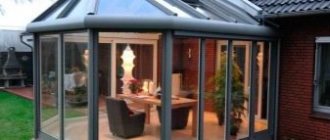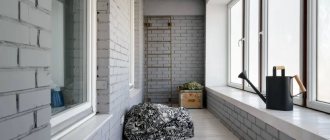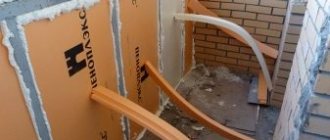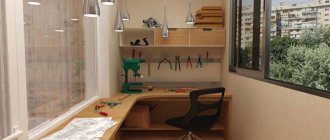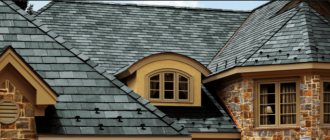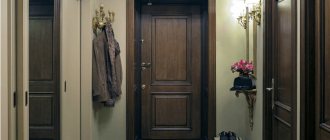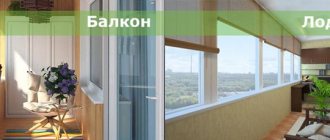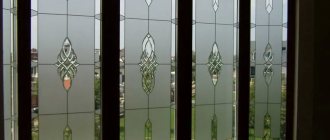Some builders are sure that the vestibule is a useless part of a private house, the heating of which wastes energy. In contrast to this opinion, most owners consider a vestibule for the home to be a useful invention, and prefer to equip their home with it. Let's figure out what functions this compact room performs, what it is like, and what materials are best used for cladding and interior design.
Entrance vestibule design Source katlavan.ru
Vestibule functions
Somewhere in the tropics, the layout of houses or cottages looks impressive and quite unusual to our eyes: from the front door you go straight into the living room. In our latitudes, such a situation is simply impossible to imagine, and the point is not at all in the lack of hospitality.
The layout of housing in temperate latitudes is greatly influenced by weather conditions. Anyone who has an idea of the changeable Russian climate can understand why a warm vestibule is needed in a private home. In autumn, winter (and sometimes in summer), cold air rushes through the open front door, and only the vestibule can stop the cold from spreading further throughout the house.
This is the main function of a compact room: it serves as a reliable buffer, protecting the comfort of the home from the vagaries of Mother Nature. In summer it saves from dampness and dust, in winter – from cold, additionally helping to save on heating.
Protection from winter cold Source ivd.ru
The vestibule is also convenient from a hygiene point of view - outerwear and outdoor shoes are stored in it. A sufficiently large extension has an additional advantage: it is convenient to store things for which there is no place in the house (for example, tools, seasonal clothes). Here they often place a staircase to the attic or second floor, or provide access to the garage.
Doors
If the extension room does not serve as a storage facility for valuables, then the door can be very ordinary, with a simple lock. Its main function is protection from bad weather and precipitation, as well as the aesthetic function of decorating the front entrance of the house. The entrance door to the house itself should not only be reliable protection from intruders, but also well insulated, preventing warm air from escaping. Ideally, the space between two doors should be one and a half to two steps of an adult, so that one of the doors has time to be closed when the other opens. Thus, both vestibule doors, at the correct distance from each other, will save on heat energy costs.
Varieties
The tambour as an idea is implemented in several ways; Structurally, it is made into an extension or part of a residential building. There is also a division into warm (with heating) and cold rooms; There are differences in the way of lighting. A modern approach to the design of private housing offers three types of designs for entrance vestibules to the house.
Porch with a protected entrance area Source ivd.ru
Seni
In a traditional Russian house, a canopy was a non-residential and unheated frame structure, which was usually built along the entire length of one side. The size of the entryway showed their importance for everyday life.
The canopy served as a heat-saving barrier and a place where things and various equipment were kept. During the cold period they were used as a convenient pantry for food. In warm weather, guests were accommodated in the hallway for the night.
In modern houses, the size of the canopy has decreased significantly, as the priorities of the owners have changed, and few people maintain extensive subsidiary farming. Increasingly, the role of a canopy is played by a glazed and insulated porch or a small extension at the front door. Tools, gardening equipment and other things that are needed at hand continue to be stored in the entryway. Here they provide access to utility (garage, boiler room) and residential premises.
An additional advantage of the canopy is that it prevents the smells and sounds of technical rooms from leaking into the house. For full use, the canopy requires a window, but it is not necessary to heat it.
Traditional style design Source pinimg.com
Hallway
A hallway means a small separate room behind the front door, which is included in the original project (it is not built separately). In small houses and apartments, the hallway is often combined with a corridor, which saves space. There is enough space to place shoe shelves, a mirror, and a closet for seasonal clothes.
In large houses, the entrance hall is transformed into a hall, a room of a larger area, but with similar functions. The hallway is part of the heating circuit of the home, so it is not heated additionally (a standard radiator will suffice). In well-thought-out designs, the hallway has a window, which allows you to save on lighting.
It is extremely useful to arrange ventilation in the hallway. This will allow you to quickly regulate air humidity, preventing condensation from occurring. In a room with exhaust ventilation, things will dry quickly; There is no need to worry about mold forming in the corners.
The glass porch leads to a small hallway Source pinimg.com
Veranda
A glazed veranda is a passage space between two entrance doors. This is a practical and therefore quite common way of organizing a vestibule, especially in the middle zone.
The advantages of the veranda are large windows and an area sufficient to create a full-fledged recreation area. On a standard veranda you can find a table with a bench or two, cabinets and a variety of storage systems (drawers, shelves).
When cold weather sets in, the veranda becomes a full-fledged buffer, a thermal cushion that reduces heat loss. The disadvantage of the veranda is the need to ensure high-quality (sealed) insulation. Among other things, you will need an insulated entrance door and double-glazed windows. The result of the arrangement will be quite expensive.
Glazed veranda with overhead light Source bau.ua
See also: Catalog of companies that specialize in redevelopment of country houses of any complexity
Glazing options
Ideally, openings for windows are included in the design of the vestibule. This helps in saving energy - during the daytime you will not have to use artificial lighting. However, in a spacious, insulated vestibule with large window openings, you will have to take care of high-quality glazing of the openings, otherwise warm air will not linger in the room. In the case of a vestibule-hallway with windows built into the thermal circuit of the house, it is necessary to install double-glazed windows, as in all living rooms.
If the vestibule-veranda does not require additional heating, then you can glaze the window openings with ordinary windows. This will solve the lighting problem and protect from rain and wind.
Dimensions
The size of the buffer zone is regulated by considerations of convenience. You should not refuse to design a vestibule in a private house just because it claims to be part of the living space, which is always in short supply. How spacious the room will be depends on several parameters.
Construction standards (SNiP and GOST) set minimum dimensions through the parameters of the depth and width of the room. With a minimum width of 1 m, the depth does not fall below 1.4 m. The limitation is related to the dimensions of the doors - there must be enough space so that they can open without interference and not interfere with the free movement of one person.
With a minimum size, the functionality of the vestibule as a buffer zone is preserved. The person leaving can close the inner door before the outer door is opened, and heat loss will be minimal.
There is a requirement due to fire safety regulations. According to him, both doors should open outward. In the event of an emergency, the inhabitants of the house will be able to leave the premises without hindrance.
Doors do not comply with fire safety regulations Source decoredo.com
A miniature vestibule-porch has a right to exist, but is not the optimal solution. It, of course, performs a protective function, but it is impossible to arrange any convenient storage spaces in it.
A design with a width of 3-4 m is more practical. In the middle room there is room for all the necessary items: wall shelves or a compact closet, a shoe shelf and a mirror. If you think that a closet is too bulky for such a room, you can limit yourself to hooks for outerwear. A medium-sized vestibule will free up useful space inside the house.
A spacious entrance area, the width of which reaches five meters or more, can be arranged according to the principle of a veranda, insulated, lighted and large windows designed. Upon completion of the work, storage shelves are installed in the vestibule and a cabinet is installed. If desired, it is easy to accommodate a small table and enjoy leisurely tea parties overlooking the surrounding landscape.
Tambour as the center of symmetry of the house Source ivd.ru
Tambour with a brick plinth Source pinimg.com
- Ventilation. It is relevant in two cases: if a metal entrance door is installed, or if the owners are going to dry clothes in a small space.
- Doors. It is important to think about their relative position. If possible, they try not to place them opposite each other, so as not to create strong drafts. Sometimes they arrange it so that both doors open inward. This makes it more difficult to create a situation in which both doors are open at the same time.
- Cleaning. By default, there is more dirt and dust in the buffer room than in living rooms. The vestibule will be periodically subjected to thorough cleaning, so for finishing it is important to choose materials that are resistant to frequent dirt and equally frequent cleaning.
The main question to be resolved is whether to make the room warm or cold. Every decision has its positive sides. A cold vestibule reduces heating costs, and economy is in trend today. It may be convenient for a family with small children: the process of dressing can sometimes be delayed, and it is more comfortable to do it in a cool room.
Options from different materials Source stroygoal.ru
A vestibule with heating has its advantages. If you install tubular radiators, they can be used for drying outerwear (usually children's clothes). A fragment of a heated floor (warm floor) can be conveniently used for drying shoes, while vegetables and fruits can be stored in cold corners.
Recommendations for arrangement
If you need to arrange a space for a hallway, you will need a closet, and you should pay attention to models with mirrored doors, as well as corner cabinets - they are often more spacious and help to use all the space wisely. If you need to store a lot of things, but you don’t want all the guests to see them, a hanging mezzanine is suitable. A vestibule veranda requires a small table, and wooden options are usually chosen, but recently stained glass and glass models have become popular. A carpet will add extra coziness, but a mat will be more practical. Place indoor plants in a warm vestibule with good lighting.
Exterior finishing materials
To build the structure, they try to use the material from which the house was built; this is guaranteed to give the composition a harmonious look. But no one forbids choosing any other material if the replacement is equivalent. For example, a combination of brick or concrete walls with a glazed entrance looks stylish.
A fairly wide range of materials is used for the construction of a vestibule in a private house; The following options are suitable for exterior design:
- Tree. A wooden vestibule is the best solution for a house made of timber or logs. The building will be durable and stylish in appearance, subject to timely maintenance and periodic (every 8-10 years) treatment with antiseptics.
Wood paneling in a modern style Source reussirsaveranda.fr
- Brick. The extension turns out to be capital, resistant to wear and weather factors; it looks good next to a brick house. Despite the high cost of construction, a brick vestibule has its advantages: it can do without interior decoration, and during operation it will serve to protect the wall of the house from the cold.
- PVC panels and PVC windows. Suitable for installing both warm and cold vestibules. The structure is erected quickly and has acceptable sound and heat insulation.
Brick, glass and metal Source stroy-podskazka.ru
Layouts of warm and cold vestibules in a private house with photos
The room may be designed together with the main building or built later, located in a recess or outside the facade on a separate foundation. The second option saves space inside the cottage and often helps reduce costs. The first planning method allows you to create an architectural project in a single style and save on insulation due to the presence of main walls. But in such a hallway it is important to think about ventilation, additional heating or a thermal curtain. There must be a partition or a staircase between it and the rooms if there is a second floor.
There is another way to protect the living area from wind and dampness. It is often implemented in conjunction with a veranda. We are talking about double doors to the main building. One of them is metal, the second is made of solid wood or MDF (preferably, it is more resistant to moisture). The optimal distance between them is 40 or 50 cm.
Video description
About the experience of using a vestibule in the Middle Urals in the following video:
- Polycarbonate. It produces an economical transparent structure that reliably protects from wind and rain. Installation is simple; An additional plus is that polycarbonate can be given a curved shape and create an original building with rounded walls.
- Glass. It is chosen to decorate the entrance to a wooden house with a vestibule in the form of a veranda. This solution looks impressive and offers a panoramic view of the surrounding landscape. The disadvantages of the glass project are the high cost of implementation and the need for regular cleaning of the glass.
Tambour on the high porch Source lr-studio.ru
- Siding. The frame is covered with siding (and inside, for example, with clapboard) and insulated; It turns out to be budgetary and practical. The material is easy to work with, and the market offers various colors and textures; therefore, the design can be easily coordinated with the decoration of the house.
- Metal. Corrugated metal sheet is quite cheap (only plastic is cheaper), easy to install, and resistant to natural influences. Due to its good performance it is becoming an increasingly common solution.
The finishing of the entrance area can be made from a combination of materials. Tandems of brick and glass, or wood and glass are popular. The roof is designed as a single or gable structure that does not allow snow and water to remain.
Construction of a glazed vestibule Source mebel-go.ru
Roof
The installation of a roof is intended only for vestibule projects that are external extensions to the main facility. For the roof of an extension, a certain configuration is required for the slope of precipitation, as well as fastenings inside the room, that is, a sufficiently strong base and frame. Do not forget about drainage so that raindrops do not fall in a stream onto the space in front of the door.
Heating systems are often installed between the roof slope and the ceiling, which are a thermal curtain of heated air flows.
Interior design
Creating a convenient and practical entrance area is the main task of the vestibule in the house; but the design of the building is no less important. In order for it to maintain functionality, they think through not only the exterior, but also the interior decoration.
The inside of the vestibule is a walk-through area, and the quality of the flooring is of paramount importance. It is subject to requirements for wear resistance, resistance to temperature fluctuations and dampness. The floor should not slip and be subject to frequent cleaning.
These conditions correspond to a tiled floor (stone or ceramic) or porcelain stoneware covering. High-quality linoleum is suitable as a budget replacement. A plank or laminate floor will require additional effort (periodic treatment), and will still wear out faster.
Country style vestibule interior Source pinimg.com
Interior of the entrance area in a country house Source hzcdn.com
Layouts of warm and cold vestibules in a private house with photos
The room may be designed together with the main building or built later, located in a recess or outside the facade on a separate foundation. The second option saves space inside the cottage and often helps reduce costs. The first planning method allows you to create an architectural project in a single style and save on insulation due to the presence of main walls. But in such a hallway it is important to think about ventilation, additional heating or a thermal curtain. There must be a partition or a staircase between it and the rooms if there is a second floor.
There is another way to protect the living area from wind and dampness. It is often implemented in conjunction with a veranda. We are talking about double doors to the main building. One of them is metal, the second is made of solid wood or MDF (preferably, it is more resistant to moisture). The optimal distance between them is 40 or 50 cm.
Briefly about the main thing
In most of Russia, equipping a private house with a vestibule is not a whim, but a necessity. The idea can be implemented in different ways: you can confine yourself to the hallway, build a canopy or veranda. The designs vary in size and design, but perform the same functions.
In order for any of these rooms to properly serve as a buffer, it is necessary to think through their arrangement, lighting and insulation. The vestibule can be made warm or cold, each option has its own advantages.
Tambours are built from a variety of materials: brick, wood, glass and plastic. Lighter, wind-protective structures are made from polycarbonate and siding. In interior design, special attention is paid to the flooring material.
Lighting
The problem of vestibule lighting is easily solved by window openings in the room, however, if the vestibule involves a completely enclosed room, voluminous in size, then it is necessary to install artificial lighting sources so as not to stumble in the dark and to be able to use cabinets for clothes and household items. Depending on the size of the room and its purpose, as a rule, overhead lighting is used, not too powerful, and, if necessary, additional sources near the mirror.
Hallway
The hallway is a special room in the house. It is a kind of calling card of the house, since guests who come to the house, and the owners themselves, first of all end up in this room. As a rule, it is equipped with a place to place the outerwear of the owners and their visitors. A shoe rack is also required.
Advice! It is advisable to place a mirror there, which will allow you to clean yourself up immediately before going for a walk.
Light colors, marble floors, crystal chandelier - a real decoration of the hallway
An important role is played by a place to store things that are recommended or necessary to take with you before going out: bag, umbrella, keys. Many owners place a closet in the hallway for storing seasonal items, as well as various household appliances.
Unfortunately, the small dimensions of our houses do not allow us to create a separate spacious hallway, so many people think that an excellent solution is to move it into the entrance annex. This is quite possible if special requirements are met.
Advice! For such a room, choose furniture that is resistant to temperature changes. This will ensure a longer service life.
Partitions made of wood and glass seem to blur the boundaries between rooms
Important! In such a room it is necessary to organize heating. It is worth installing a door between it and the rest. To avoid the formation of dampness and moisture, which can subsequently cause the appearance of fungus and mold, it is necessary to install a hood.
Today the word "seni" seems so outdated that it is found mainly in villages. But these were the first options for arranging the vestibule. But few people remember its meaning.
- A canopy is a special room that is both a connecting and buffer zone between housing and outbuildings.
Our ancestors united a house and a barn under one roof. But, fortunately, today this technique is increasingly being abandoned. A garage, workshop and other buildings can be used as an adjacent building. This allows you to get from one room to another without going outside, which is very convenient, especially in winter.
A modern solution - a large extension that can be arranged at your discretion
The canopy protects not only from natural phenomena and debris coming from the street, but is also an excellent barrier to odors and noise coming from the outbuilding. Despite this, experts recommend installing ventilation in non-residential premises.
Advice! If an additional entrance is made to the boiler room from the street, then with the help of a canopy it can be connected to the woodshed.
This type is unheated. When choosing a door, you should give preference to a glazed one or find a place for a window to ensure sufficient sunlight.
House porch covered with polycarbonate: elements
To make the entire structure as light as possible, owners of houses and cottages often decide to completely cover the porch with polycarbonate. For this purpose, special frame elements are used.
- Profile. It connects sheets of polymer, which increases the strength of the structure and eliminates the use of intermediate elements. The profile can be of various types; its varieties are presented in the figure below.
- Thermal washers. This element is protective as it prevents the structure from leaking. They can have different shades, which makes them invisible against the general background.
- Special profiles. These elements are selected taking into account the characteristics of the polymer sheets used. The absolute identity of the sheets and connecting panels ensures a harmonious appearance of the structure.
- Coextrusion layer. This is a special coating that is applied to protect against the negative effects of UV rays. The coating allows you to extend the life of products.
Veranda
The veranda is an excellent option for arranging an obstructed space. How is this structure different from others? The answer is very simple: the veranda is a bright room in front of the entrance. This is due to the large number of windows.
A huge veranda serves as a place for rest and relaxation
Walls can be built from brick, foam block and other materials. They can also be made of wood, but in this case they need to be insulated.
The modern market for building materials makes it possible to build a fully glazed veranda using metal-plastic structures equipped with double-glazed windows for the base.
On a note! Usually the veranda is not heated. It serves as an excellent place to relax in the spring and autumn.
Floor, walls and ceiling
Decorating the ceiling in the vestibule is usually not difficult. It is most often plastered and left white. As an option, choose one of the types of suspended structures.
But with the floor, everything is more complicated - there are many options for choosing floor coverings. It is possible to dwell on any specific one of them only after a detailed study of the issue. Here are the most common options
- Corrugated iron sheets. Excellent resistance to any adverse environmental factors, somewhat unusual appearance.
- Concrete floor . Some homeowners prefer concrete without additional coatings. Reliability and durability are captivating, but aesthetics suffer. Take into account the fact that the concrete floor is always cold.
- Linoleum . Inexpensive, stylish, but extremely impractical. In winter, being outside is slippery and the material tears easily.
- Moisture resistant laminate . Not a bad option. Looks good, lasts longer.
- Ceramic tile . It is used very often and has many advantages. One has only to take into account that this material is fragile and does not withstand mechanical stress.
Entrance groups made of metal structures
Aluminum entrance group
The main competitor of entrance groups based on PVC profiles is aluminum entrance groups.
Using aluminum as a structural material offers many advantages. It is cheaper than extruded plastic, more wear-resistant, and its strength characteristics make it possible to glaze large surfaces - entire facades. Based on aluminum profiles, it is easy to create not only swing and tilting structures, but also sliding, “pendulum” and similar aluminum doors for entrance groups.
Insulated aluminum entrance group
Aluminum entrance groups have only one serious drawback: they are cold. Aluminum is an excellent heat conductor. And the cold, accordingly
The entrance group made of an aluminum profile can be insulated by introducing thermal bridges into the profile, installing seals, and replacing single glass with a double-glazed window. But its cost will increase and become comparable to metal-plastic. For glazing entrance areas, this approach is hardly reasonable: they, by definition, are cold or open rooms.
An article with the same title on our website will help you choose a fencing for the entrance group. Another material on our website will help you choose a glass fencing for the entrance group. Read about what types of forged fencing there are, read here: https://oknanagoda.com/balkony- lodzhii/remont-otdelka/kovanye-ograzhdeniya.html
One can imagine that using a stronger material, stainless steel, instead of aluminum would bring additional benefits to profiles like Provedal or Krauss. But in reality, such a solution is rarely used. Most often - in the manufacture of entrance groups made of metal with increased anti-burglary properties. Using armored glass, powerful fittings, etc.
Entrance group with glazing on steel profiles
The production of entrance groups of this type is an expensive and technically complex task. Therefore, they are used only in the most critical areas: at the entrance to certain premises of banks, especially important archives, etc. In general building entrance groups - very rarely.
In everyday life, stainless steel entrance groups refer to the fencing of main staircases, platforms in front of the entrance to a building, in which metal structures - racks, columns, pylons - serve only as strength elements. They do not, unlike profiles, cover the edge of the glass, but only support it using brackets or remote fastening with “coins” or other similar methods.
This kind of fencing does not protect from cold, noise or dust. They play only a decorative role. But they are convenient for anti-criminal purposes. Metal entrance groups of banks filled with extensive sheets of tinted bulletproof glass serve to shelter guards and safely monitor the street.
Entrance group with forged fencing
Metal entrance groups also include forged entrance groups. That is, those whose elements are made of wrought iron or iron. As a rule, this is the fencing of stairs and platforms near the entrance to the building; brackets supporting the canopy.
Forged entrance groups have high decorative properties. But this is their only advantage. They are heavy and expensive. They are only sometimes used for anti-vandal protection of windows - instead of the usual welded grille.
Required parameters
Owners of private houses today are increasingly abandoning unnecessary extensions or seeking to make them multifunctional. The standard vestibule has slightly different parameters and differs from the one that is now customary to attach to houses.
Important! According to building regulations, it must be at least 1.2 meters deep. To increase its protective functions, it is worth installing a door at the entrance. It is desirable that it be equipped with glass. This will ensure light enters the room.
The glazed door will perfectly preserve the microclimate in the vestibule and provide a lot of daylight
Important! Fire safety rules stipulate that the door between the street and the vestibule, as well as the one leading into the house, must open outward.
But, as you know, this requirement does not apply to private buildings, so its compliance is recommended, but not mandatory. It is also known that a standard vestibule is not equipped with heating. Modern extensions at the entrance to the house are somewhat different from these standards.
Choosing a door design
A double door can allow you to do without a vestibule altogether, but you need to choose the appropriate one. And even if there is a vestibule, the quality of the front door is still very important. Usually it is metal and always insulated.
Main fillers:
- Mineral wool, preferably basalt, is the most dense. It is capable of effectively retaining heat, but poor quality material settles strongly, after which the door begins to freeze.
- Polystyrene foam is cheap and lightweight, while successfully retaining heat, but due to its low density it is poorly suited for sound insulation, and is also flammable.
- Expanded polystyrene is stronger than polystyrene foam and retains its shape well, but if the joints are poorly foamed, and even more so if they are not foamed at all, cold air will penetrate through them. Also not recommended from a fire safety point of view.
- Polyurethane foam insulates heat and sound well, is durable and moisture-resistant. One of the best fillers, but doors with it will not be cheap.
To be able to set a higher temperature in the vestibule and avoid the formation of moisture or icing, doors with a thermal break are used.
When choosing a door, it is important to check that the leaf is securely adjacent to the block, and that the seal is of high quality. Often you have to deal with savings - for example, seals made of foam rubber or thin rubber wear out quickly and can harden in cold weather. Before purchasing, it is useful to carry out a simple test using a sheet of paper - you need to place it between the canvas and the block, and then close the door. If the sheet falls out easily, then the connection is not tight.
